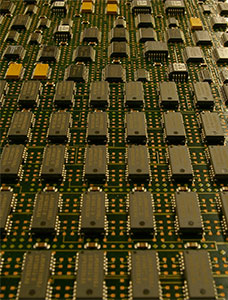The EU's Restriction of Hazardous Substances (RoHS) directive took effect in 2006 (applies to Lead (Pb)),
Why was lead solder typically used?
Lead solder was technically an alloy of lead and tin and was sometimes referred to by its chemical formula, Pb-Sn. Lead solder was used heavily for PCB production because it:
• Cools slower than other metals, which reduces the chances of cracking of the joint
• Wets joints well, which provides a good electrical connection for leads and PCB pads
• Has a melting point rather than a melting range for the blend used in PCB production, 63% tin and 37% lead, which facilitates automation of PCB production with reflow ovens
• Has a lower melting point than lead-free alternatives, making it less likely to damage electronic component.
Benefits of lead-free solder
Lead-free solder can include a variety of chemical elements, such as tin, silver, gold, copper, zinc and manganese. One of the most common includes tin, silver and copper and is abbreviated SAC, after the chemical symbols for tin (Sn), silver (Ag) and copper (Cu).
The primary benefit of lead-free solder is that it is safer than lead versions. Lead is a powerful neurotoxin. Although most of the focus on lead poisoning has been on children exposed to lead paint, anyone can suffer from lead poisoning, including electronics assemblers.
Among other benefits, lead-free solder:
• Does not wet as well as lead solders. When connection pins are spaced very close to one another, the reduced wetting prevents solder bridges
• Creates joints that are harder than lead joints, giving them better mechanical properties
• Are compatible with existing manufacturing processes for a seamless transition from lead solders
Drawbacks of lead-free solders
Despite their benefits, lead-free solders are not flawless. In fact, the EU has granted a few exceptions to the lead-free directive to accommodate certain applications. For example, some ceramic capacitors can only be produced using lead solders and are therefore exempt from the EU directive.
Other drawbacks of lead-free solders include:
• Lead-free solders are prone to whiskering, a phenomenon where tin forms electro-conductive crystalline structures. Whiskers grow spontaneously in some soldered joints that are high in tin
• The melting temperature is not as stable, predictable or narrow as that of lead solders, sometimes leading to defects when solder fails to melt completely
• The melting temperature is higher than that of lead solder, and can damage PCBs and electronic components during manufacture.
From <
Learn the differences between lead and lead-free solder and the benefits of using lead-free solder for your PCB products.

huntron.com
>




